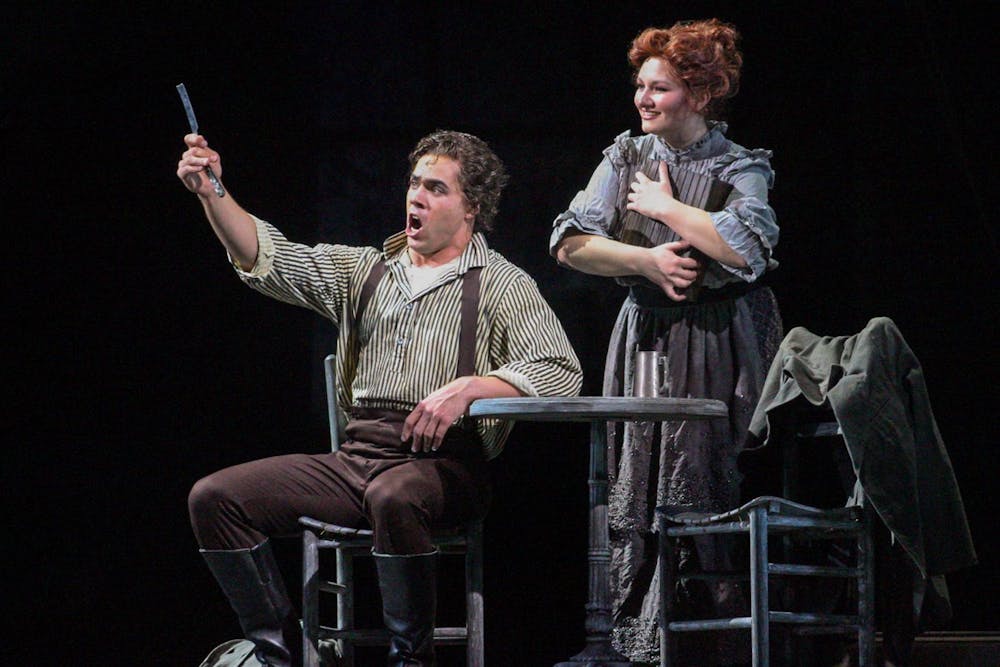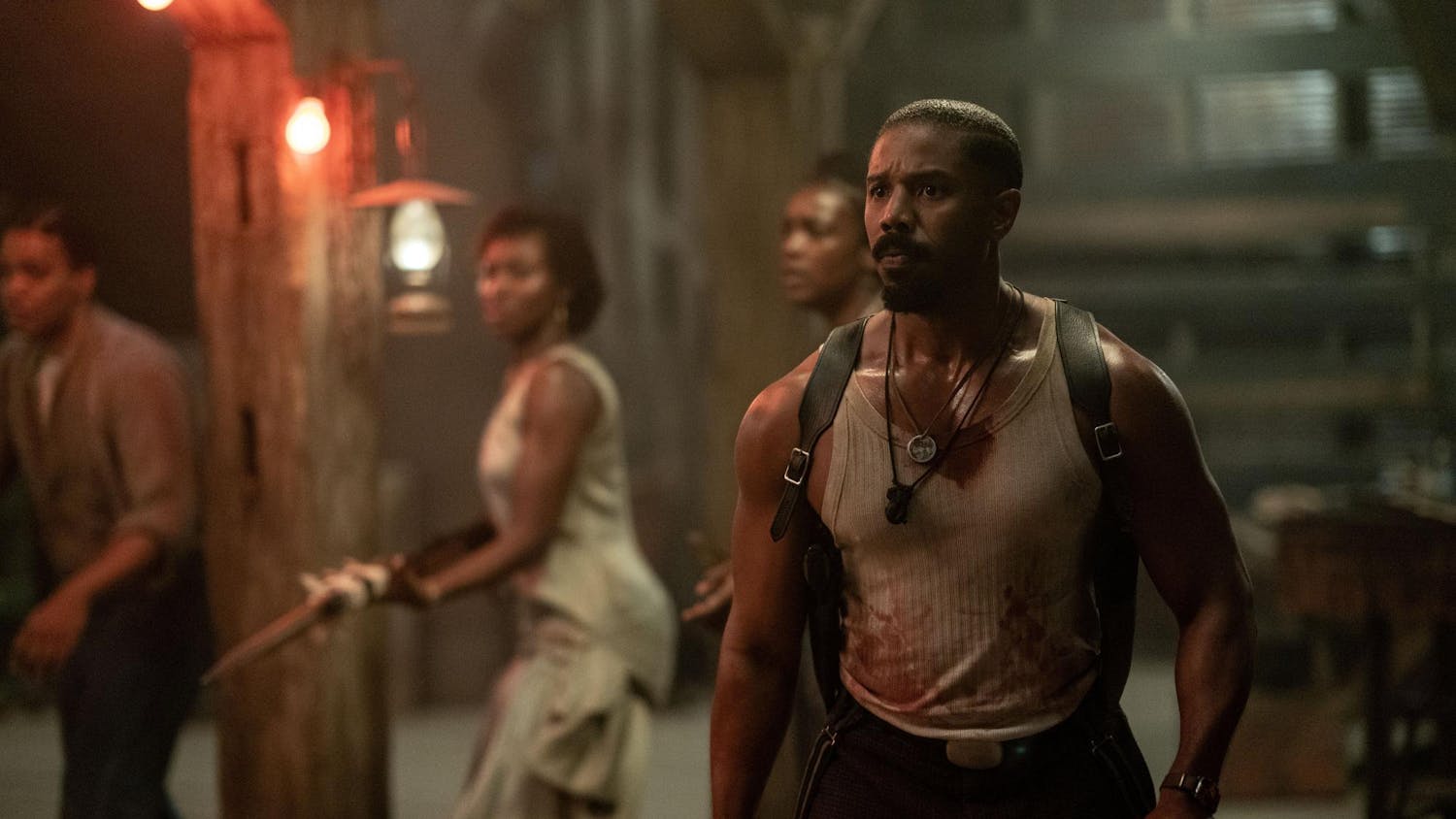Editor’s note: This story contains mention of fake violence and gore.
“Sweeney Todd: The Demon Barber of Fleet Street,” is a musical full of gore, revenge and madness. Presented with a world filled with acts of vicious murder, the IU Jacobs School of Music design team was faced with the challenge of making the violence look believable. The “blood” had to be handled with care.
For each kill that occurred on stage in Todd’s barbershop, an ensemble member came downstage center and poured a bucket of stage blood down a hollowed part of the stage with a grimace on his face.
As the actor moved downstage with the bucket for each kill, Todd’s growing resentment toward the world and hunger for revenge became deranged as he ruthlessly sliced the throats of his victims in his barbershop.
Wrongfully imprisoned in Australia for 15 years on trumped-up charges, Todd is rescued at sea by a young sailor named Anthony Hope, who later becomes romantically involved with Todd’s daughter, Johanna.
Beaten by the strict class-based society that ruled over Victorian-era England, Todd’s thirst for vengeance against those with power leaves him resorting to an old friend to accomplish the task: his straight razor.
The IU Jacobs School of Music’s production of “Sweeney Todd” closed April 13 after a successful two-show run in the Musical Arts Center.
The cast featured a wide age range from undergraduate and master’s students to older students pursuing their doctorates and performer's diplomas. Each of the principal characters were double cast and sorted into two different casts, the Cream and the Crimson.
The character of Todd was shared between two older students. Sam Witmer, a first-year doctoral student in voice performance who hopes to one day teach at the Jacobs School of Music, and Skyler Schlenker, who is completing a performer’s diploma at the Jacobs School of Music. Witmer performed Friday's opening show with Schlenker closing the run on Saturday.
Sweeney Todd, a man wronged by the higher powers of society, swears vengeance against Judge Turpin for his wrongful imprisonment and for taking his daughter, Johanna, as his ward after assaulting Todd’s wife.
“He’s waiting for God to do justice,” Schlenker said.
For Witmer and Schlenker, Todd is a character of great complexity and trauma. He needed molding and development to truly live up to his potential. This had to be done by becoming closer with the razor.
“That instrument of his profession that has stayed by him for so long through all of the weakness and corruption of society is the thing that he really bonds with,” Schlenker said.
On the third floor of the MAC in rehearsal room 301, the relationship between Todd and his razor was worked and trialed. Each rehearsal was spent trying to communicate this relationship through Sondheim’s passionate lyrics and Todd’s mannerisms.
Both actors agreed that the razor itself was the one thing that remained of Todd’s former life. It is the symbol of his status as a merchant, a barber returning to his craft after so many years away.
However, with Todd’s skill, it seems he never left his barber profession as he successfully beats his opponent in a public shaving contest. To reflect this skill, the two actors used the razor at almost every rehearsal when it was needed. Each rehearsal’s time was split evenly between them.
As either Witmer or Schlenker worked on the scene with the props and focus of the director, Michael Shell, and the conductor, Constantine Kitsopoulos, the other was doing the same work quietly in his shadow at the back of the room. Then, the actors would switch so the other could get the chance to do the scene with the props, setting and music all together.
This switch occurred numerous times throughout rehearsals, which were held every Monday through Friday, with some rehearsals taking place on Saturdays. From 4:30 p.m. to 10 p.m., the rehearsal room buzzed with excitement as the actors slowly created the world of “Sweeney Todd.” 
With the building of Todd’s character came the preparation with the razor itself. Sondheim’s musical is no stranger to gruesome killings and intense acts of violence. To ensure the safety of the actors, a check-in was done at each rehearsal that involved a weapon, no matter how small it was.
The methods of execution, including how the actors would “slice” the razor across the throats of the other cast members playing Todd’s victims, was demonstrated by the fight choreographer, Matt Herndon, in particular detail. This also included how Todd would hold the razor itself and how to extract and close it properly.
Herndon's work helped shape what the moments with the razor would look like on stage.
Herndon’s main task as a fight choreographer is to make the kills look believable while maintaining a safe environment for the actors. Much of Herndon’s expertise comes from establishing the basics first with the creative team before diving into the choreography itself. This allows his performers to practice and learn safely while building skills they can hopefully take with them into their professional careers.
Herndon’s inspiration came from Sondheim’s own words. The lyrics, stage directions and music all held clues that painted the experience. Todd’s mannerisms with the razor are disorderly with his first kill but after some practice, his kills become clean and precise.
“In Sweeney’s case, you have to be very intentional with how he wields the razor. To be direct with it. Don’t treat it like a random baton but like another character,” Herndon said.
Sweeney becomes delicate with his work and therefore delicate with his razor. He moves his body swiftly to deliver a smooth cut while letting the razor glide across the throats of his victims. It becomes second nature for him, a new way of life.
For Herndon, the relationship between Todd and his razor is mutual. They are both one in the same.
With Herndon’s guidance, Witmer and Schlenker rehearsed their slices and learned to handle the razor in a way that enhanced their performances. Now equipped with the proper handling of the razor, the pair were able to create their own interpretations of Todd's character that the audience would remember.
“Trauma can turn you into the worst version of yourself. That what doesn't kill you doesn't always make you stronger,” Witmer said.
Both actor’s performances as Todd reflected this trauma as he transformed from a vengeful man to a maddened killer. The razor, as Todd’s flawed instrument of justice, later became the tool of his own destruction. 
In the final scene, as Todd sits on the floor of the bakehouse, clinging to his dead wife, he is confronted with his atrocities through Tobias Ragg, an assistant to Mrs. Lovett in her meat pie shop. The boy sneaks behind him, places his left hand on Todd’s left shoulder, raises the razor high into the air and slices it straight across his throat.
There is no blood pour for this kill, as the blood smears across the actor’s neck from a hidden tube under Tobias’ shirt attached to his right wrist which gives the blood effect as he glides his hand across the actor’s throat.
The deed is done as Todd hunches over in pain, gasping for breath like his victims before him. But, like them, he ultimately slumps to the ground. Seconds later, he is dead — just another dead body on the stage.
Every aspect of Todd’s humanity has been lost due to his inability to not let his revenge consume him. His murderous killing spree and life have been ended by his own razor.
What began in room 301 of the MAC, through the deserving work of a devoted team, has become a tale of bloodlust and horror: the tale of Sweeney Todd.




